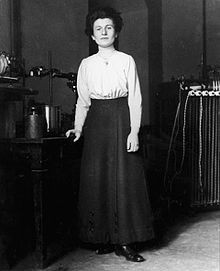Hedwig Kohn
This article needs additional citations for verification. (February 2007) |
Hedwig Kohn | |
|---|---|
 Kohn in her laboratory, 1912. | |
| Born | April 5, 1887 |
| Died | March 26, 1964 (aged 76) |
| Citizenship | German |
| Alma mater | Breslau University |
| Scientific career | |
| Fields | Physics |
| Institutions | Breslau University University of North Carolina Wellesley College Duke University |
| Thesis | (1913) |
| Doctoral advisor | Otto Lummer |
Hedwig Kohn (April 5, 1887 – March 26, 1964) was a Polish-born physicist who was one of only three women to obtain habilitation (the qualification for university teaching in Germany) in physics before World War II.
Because she was Jewish, she was forced to leave Germany during the Nazi regime and continued teaching after ultimately settling in the United States.
Early life
Born in Breslau (now Wrocław, Poland), Kohn was the daughter of Georg Kohn, a wholesale merchant of fine cloth, and Helene Hancke, a member of a well-to-do family.[1] Her parents were both German Jews.
Hedwig entered the university in Breslau in 1907 as the second woman in the physics department.[2] She obtained her doctorate in physics under Otto Lummer in 1913 and was soon appointed as Lummer's assistant.[1] She stayed at the university's Physics Institute during World War I and obtained her habilitation in 1930.[1]
Kohn was trained by Lummer in the quantitative determination of the intensity of light, both from broad-band sources, such as a "black body", and from the discrete emission lines of atoms and molecules.
Escape from Germany
Kohn was dismissed from her position in 1933 due to Nazi regulations which barred Jews from government service.
She survived by fulfilling contracts for applied research in the illumination industry until 1938, when she found herself without work or financial resources and came very close to being a victim of the Holocaust.
Hedwig Kohn was given a visa to the United Kingdom in 1939, however, it was immediately cancelled due to World War II. She got a visa to travel to Sweden in 1940 and immediately went there. After this, she obtained a visa from the United States and moved there.[1]
Finally, she was offered temporary positions at three women's colleges in the United States through the aid of Rudolf Ladenburg, Lise Meitner, Hertha Sponer, the American Association of University Women (AAUW), and many others.[1] She obtained a visa and left Germany in July 1940.
Life in United States
The journey to her first position at the Women's College of the University of North Carolina in Greensboro took Kohn through Berlin, Stockholm, Leningrad, Moscow, Vladivostok, Yokohama, San Francisco, and Chicago.
She taught at the Women's College of the University of North Carolina at Greensboro for a year and a half. In 1942, she began teaching at Wellesley College in Massachusetts.
She retired in 1952 as a professor. Upon her retirement, Hertha Sponer, then professor of physics at Duke University in Durham, North Carolina, offered her a position as a research associate. Kohn set up a laboratory at Duke University and resumed research, where she guided two graduate students to their doctorates and recruited two post-doctoral fellows.
She worked there until very shortly before her death, in 1964.
Contributions to science
Kohn was trained by Lummer in the quantitative determination of the intensity of light, both from broad-band sources, such as a "black body", and from the discrete emission lines of atoms and molecules. She further developed such methods and devised ways of extracting information from intensity measurements and from emission line shapes. She wrote 270 pages in the leading physics text of the 1930s and 1940s in Germany, received one patent, and wrote numerous articles in scientific journals, some of which were still being cited into the 1980s.[citation needed] Two of her students became professors in Germany.
Selected bibliography
- Müller-Pouillets Lehrbuch der Physik. (II. Auflage), unter Mitwirkung zahlreicher Gelehrter herausgegeben von A. Eucken, O. Lummer (+), E. Wätzmann. In five volumes: I. Mechanik und Akustik; II. Lehre von der strahlenden Energie (Optik); III. Wärmelehre; IV. Elektizität und Magnetismus; V. Physik der Erde und des Kosmos (einschl. Relativitätstheorie). Braunschweig: 1925–1929. Band II, Zweite Hälfte, Erster Teil (Volume II, 2nd half, 1st part), volume editor Karl W. Meissner: 1929.
- Kohn, Hedwig. In Band II, Chapter 22, Photometrie. 1104–1320; Chapter 25, Temperaturbestimmung auf Grund von Strahlungsmessungen. 1428–1469; Chapter 26, Ziele und Grenzen der Lichttechnik. 1470–1482.
- Kohn, Hedwig, Umkehrmessungen an Spektrallinien zur Bestimmung der Gesamtabsorption und der Besetzungszahlen angeregter Atomzustände, Phys. Zeitschrift 1932: 33, 957-963.
References
- ^ a b c d e Winnewisser, Brenda P. "Hedwig Kohn". Jewish Women's Archive. Retrieved 5 April 2019.
{{cite web}}: Cite has empty unknown parameter:|dead-url=(help) - ^ Kuhn, Thomas S. (7 June 1962). "Oral History Interviews: Hedwig Kohn". American Institute of Physics. Retrieved 2019-04-05.
{{cite web}}: Cite has empty unknown parameter:|dead-url=(help)
Further reading
- Winnewisser, Brenda P (November 2003). "Hedwig Kohn – eine Physikerin des zwanzigsten Jahrhunderts" [Hedwig Kohn - a physicist of the twentieth century]. Physik Journal (in German): 51–57.
- Winnewisser, Brenda P. (1998). "The Emigration of Hedwig Kohn, Physicist, 1940". Mitteilungen der Österreichischen Gesellschaft für Wissenschaftsgeschichte. (in German): 41–58.
Communications of the Austrian Society for the History of Science
- Winnewisser, Brenda P (2007). "Hedwig Kohn". In Hyman, Paula E.; Ofer, Dalia (eds.). Jewish Women. A Comprehensive Historical Encyclopedia (CD). Jerusalem: Shalvi Publishing. ISBN 978-0827608672.
{{cite book}}: Cite has empty unknown parameter:|1=(help) - "Hedwig Kohn Photo Collection". American Institute of Physics, Emilio Segrè Visual Archives. Retrieved April 5, 2019.
External links
- 1887 births
- 1964 deaths
- 20th-century German scientists
- 20th-century physicists
- 20th-century women scientists
- Duke University faculty
- German emigrants to the United States
- German physicists
- German Jews
- German women physicists
- Jewish inventors
- Jewish physicists
- People from the Province of Silesia
- People from Wrocław
- Wellesley College faculty
